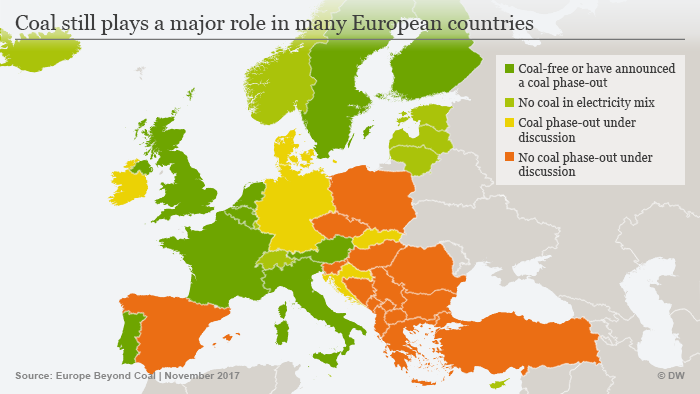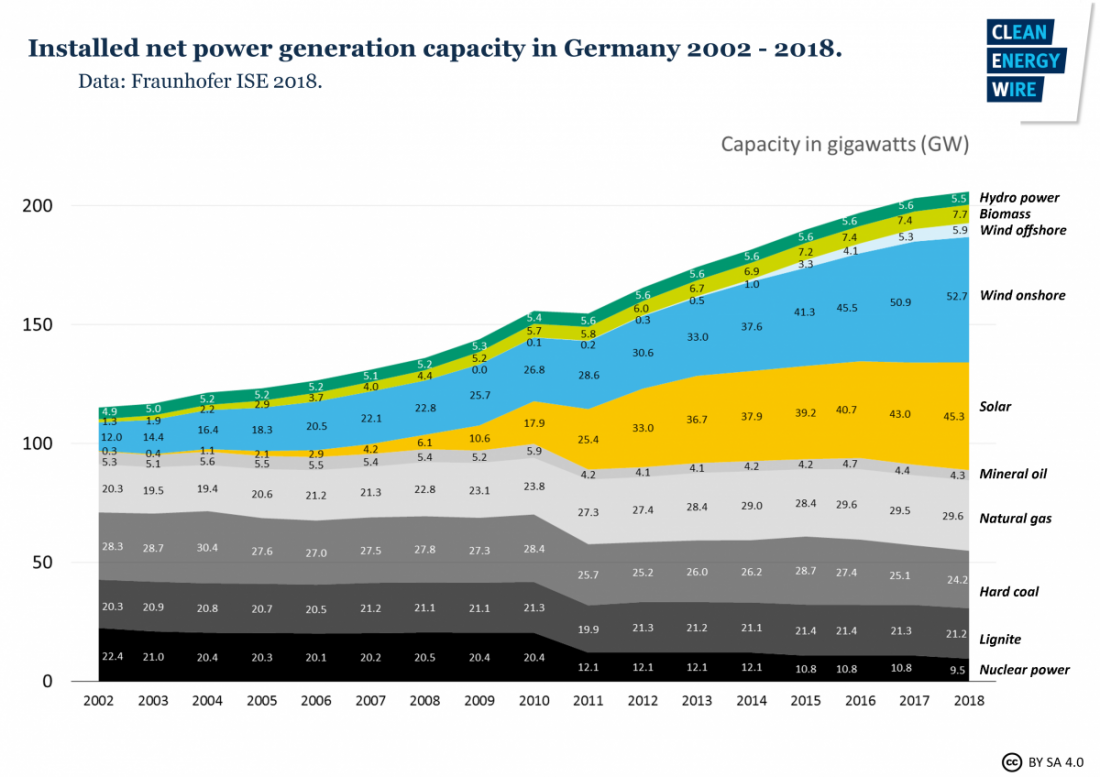This is the end of my series about my summer trip and the lessons I learned when I visited Germany. In last week’s blog, I promised to finish up my examination by comparing Germany’s energy transition efforts with those of the rest of the world. I am fulfilling this promise here by focusing on the country’s efforts to remove coal from its energy mixture, as part of its ultimate goal to convert its economy to carbon neutral.
Figure 1 shows a global map highlighting specific regions, countries, and cities that have committed to net zero carbon by 2050 or before. Germany is not part of this esteemed group. However, it is marked—as part of the European Union and on its own—as exploring the resolution.
In almost all cases of commitment to net carbon zero by 2050, the first hurdle is removing coal as an energy source in electrical power delivery. Figure 2 demonstrates the state of this decision among European countries. Again Germany is one of those that are discussing such a phase-out (as opposed to Spain, Poland, and many other countries that are not).

Figure 3 (reposted from last week’s blog) shows the detailed evolution of the spectrum of energy sources powering the German electrical grid from 2002 to 2018.
Table 1 shows the quantitative evolution of the various energy sources from 2002 to the present. As can we see in Figure 3, the capacity of electric power in Germany over this period expanded by 79%. Figure 3 and Table 1 give the power capacity in gigawatts (billion watts).
Table 1 – Comparison of Germany’s energy sources powering its electrical grid in 2002 and 2018 (GW)

Table 2 shows that almost all of the increase in the use of electricity came from the newly installed sustainable energy in solar and wind (wind also falls within the category of solar). Germany’s energy transition began with a massive shift to electricity use powered by sustainable wind and solar sources, rather than leading with an end to coal use.
Table 2 – Data from Table 1, translated into broader categories

Over this period, the German population stood around 81 million people and didn’t increase (partially due to a relatively low fertility rate). The real GDP/person in chained euros stood at 600 million in 2002 and increased to 747 million in 2018. The chained euros method (or chained volume series) is a relatively new approach to illustrating the “real” value of a currency. It involves adjusting the value of the currency to reflect inflation over time, making it easier to compare figures from different years.
By this account, the real GDP value increased by less than 25% over this period. So the shift to electrical power is an energy transition driven by neither population nor changes to the GDP.
After the Fukushima nuclear disaster in 2011 in Japan, Germany announced that it would stop using nuclear energy. However, Tables 1 and 2 both show that nuclear energy already constituted a relatively small percentage of Germany’s power sources, and the change didn’t have a particularly large impact on the country’s electricity production. Meanwhile, Figure 3 shows the sharp change in nuclear energy use in 2011, from 20.4-17.1GM.
That brings me to coal.
Germany is using two main kinds of coal: lignite (brown coal) and hard coal. Lignite is the lowest-quality coal, usually formed from compressed peat (60-70% carbon content and 10-20 million Joules/kg of heat content). It is also the lowest-cost coal, often found in shallow deposits close to power sources. Hard coal, such as anthracite (92-98% carbon content and 26-33 million Joules/kg of heat content), comes exclusively from deep mines in just a few countries in the world, which makes it significantly more expensive. We can see from Table 2 that as of 2018, the installed capacities—that is, the maximum output of electricity that a generator can produce under ideal conditions—of lignite and hard coal in Germany’s power generation were similar. However, an announcement came from Berlin earlier this year that:
Germany, one of the world’s biggest consumers of coal, will shut down all 84 of its coal-fired power plants over the next 19 years to meet its international commitments in the fight against climate change, a government commission said Saturday.
Shortly after this announcement, Chancellor Angela Merkel made a follow-up statement about the timeline for this undertaking:
TOKYO (Reuters) – German Chancellor Angela Merkel said on Tuesday that her country would withdraw from coal-fired power production by 2038, showing her support for the deadline recommended by a government-appointed commission.
The so-called coal commission said last month that Germany should shut down all of its coal-fired power plants by 2038 at the latest and proposed at least 40 billion euros ($45.7 billion) in aid to coal-mining states affected by the phase-out.
Chancellor Merkel was voicing the decisions of a power commission that reflected the transition’s various stakeholders. Below are some of the details of this commission:
4.2 June 2018: the Coal Commission is set up
In June 2018, the federal government moved to set up the Commission for Growth, Structural Change and Employment (Kommission Wachstum, Strukturwandel und Beschäftigung, KWSB). In principle, this is the round table with representatives of environmental associations, trade unions, business and energy associations, the affected regions and scientists that Agora Energiewende had advocated two and a half years earlier.
The Coal Commission was given a mandate to develop a plan to gradually reduce and shut down coal-fired power generation, including a completion date and the necessary accompanying legal, economic, social, renaturalization and structural measures. The plan was to be completed prior to the UN climate conference in Katowice in early December 2018. This timing was intentional: Federal Environment Minister Svenja Schulze was to take the international stage to announce that Germany, the world champion lignite user, is setting a rational course to address climate change. Everyone knows that Germany has been diligently expanding renewable energies and shutting down dangerous nuclear energy. However, everyone also knows that coal is largely responsible for Germany’s failure to meet its climate targets and the stagnation of its transition to renewable energy.
1.2 Funding for coal mining regions
The Coal Commission made recommendations on how to organize structural change in the coal mining regions in terms of industrial and employment policy. The central theme of the Coal Commission on the policy side was to cushion the impact of structural change.
The prime ministers of the coal states have demanded billions of euros for the structural change and will probably get them. The Coal Commission proposes a law to secure €1.3 billion annually over 20 years, distributed to all four coal mining regions. In addition, €0.7 billion per year are to be made available by the federal government independently of the budget. Together, this amounts to the €40 billion over 20 years that are currently being cited again and again in the media. It is not yet clear which region will get how much. An allocation formula still has to be found. A colorful bouquet of proposals for structural development in the coal mining regions – around 180 pages – was appended to the report. The projects can be broadly categorized in five main areas of action:
-
Promotion of infrastructure expansion and acceleration (e.g. research on the supply of liquefied gas)
-
Promotion of public service measures (e.g. provision of a railway link from the rural district of Helmstedt to the regional center of Wolfsburg)
-
Economic promotion and development (e.g. Green Battery Park Euskirchen)
-
Promotion of R&D, science and innovation (e.g. establishment of a mobility research center at the Kerpen autobahn intersection)
-
Labor market policy, development of skilled workers (e.g. postgraduate studies in Intelligent Manufacturing at the Bautzen University of Cooperative Education)
As it turns out, while coal removal was not Germany’s first step, it remains a very important component in the energy transition. As I have mentioned several times on this blog, every step in the energy transition, no matter where or when it takes place, involves winners and losers. If the “losers” of such a transition are not consulted and compensated, they will do everything in their power to block any progress (see the Yellow Vest demonstrations in France (December 18 and 26, 2018 blogs). I will continue to follow up on how Germany contends with these issues.



I think its very interesting that the goal of zero-net carbon emissions might be realized by some regions in the year 2050. While it is certainly an ambitious goal, I wonder if there are other regions that are focusing more on damage-reversal than future innovations. “An ounce of prevention is worth a pound of cure” goes the adage. Countries that focus on removing the causes for carbon emissions do more over time to help the environment. However, we cannot discount the fact that damage has been done and there is a very real need for countries to focus on removing pollution from the environment, not just preventing new problems.
Once Germany transitions from the use of coal ; would they help third world countries turn to renewable energy as well ? As stated in the article the “losers ” would prevent the transition if not compensated, what are some of the preventative measures they would take ? Would Germany be prepaired if they cannot compensate then ?
What did the UK, France, Italy, and Nordic countries do differently that allowed them to transition away from coal faster and have their electric costs risen as a result relative to Germany? Is there a possibility that re-consideration of nuclear power could help Germany achieve net zero faster than is currently the case if safely managed? Beyond reducing coal usage what steps would Germany have to take to get to net zero by 2050 would their existing pace of solar and wind power adoption get them there on time? Hopefully they can get away from coal and then Eastern European countries can implement the successes of Western European countries with the coal phase out.
Through your very informative report of Germany’s transition away from coal, I have concluded that although there are challenges in transitioning to cleaner energy sources, it is still possible. “If the “losers” of such a transition are not consulted and compensated, they will do everything in their power to block any progress”. I am interested in seeing how Germany will overcome this challenge in your follow up blog post.
This is an informative blog. It’s great that many European nations are taking steps toward or considering phasing out fossil fuels. I think that Germany is doing it in a smart way by developing and improving renewable energy technology while gradually decreasing dependence on fossil fuels to make the transition as smooth as possible on the economy. My question is whether the nation is considering a phase out of coal only or is it striving to achieve carbon neutrality by complete reliance on renewable energy? The reason I’m asking is that the blog only mentions effort to get rid of coal while improving other energy generating infrastructure. Is coal Germany’s only target then?
This was a very interesting and informing blog. Germany is one of the largest economies in the European Union and in the world. But as I was reading I noticed from Figure 1 that mostly first world countries took the pledge for clean energy. I was wondering if second or third world countries are as committed fighting climate change as developed nations have?